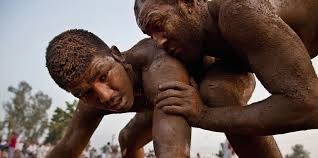Indian sports have a rich and diverse history, reflecting the country’s cultural heritage, traditions, and societal evolution. Here’s a look at the transformation of Indian sports from ancient times to the present day:
Ancient and Medieval Times:
-
Malla-yuddha (Wrestling):
- One of the oldest known Indian sports, dating back to the Vedic period (around 1500 BCE). Wrestling was a popular combat sport and was part of ancient military training.
- Mahabharata references various wrestling matches, and it was also practiced in royal courts.
-
Chaturanga (Ancient Chess):
- Originating in India around the 6th century CE, Chaturanga is considered the precursor to modern chess. It involved strategic thinking and was played by royals.
-
Kabbadi:
- Originating in ancient India, it is a contact sport that involves two teams. It’s believed to have been played as early as 4,000 years ago and has roots in South Asian villages.
-
Polo:
- Polo, known as Sagol Kangjei in Manipur, has ancient roots in India, with records indicating it was played as early as the 6th century. The game gained royal patronage and evolved into the modern polo we know today.
-
Archery:
- Archery was an important skill during ancient times, especially for warriors in epic tales like the Mahabharata and Ramayana. Archers were revered for their precision and skill.
Colonial Period (18th-19th Century):
-
Introduction of Western Sports:
- The British colonial period brought European sports like cricket, football, and tennis to India.
-
Cricket:
- Cricket became popular under British rule, with the first recorded match being played in 1721. By the late 19th century, India had its own regional competitions, leading to the formation of the Indian cricket team in 1932. India’s victory in the 1983 Cricket World Cup marked the beginning of the country’s passion for the sport.
-
Football:
- Football was introduced during British rule, and clubs like Mohun Bagan (founded in 1889) became crucial in Indian football’s history. The 1911 IFA Shield victory by Mohun Bagan, a major event in Indian football history, symbolizes the rise of football in the country.
-
Field Hockey:
- Field hockey gained significant importance, and India dominated the sport during the early and mid-20th century, winning multiple Olympic gold medals (including 6 consecutive golds from 1928 to 1956).
Post-Independence Period (1947 – 1990s):
- Rise of International Sports:
- After independence in 1947, India made significant strides in the global sports arena.
- Cricket’s Growth:
- Cricket became a national obsession, and India’s performance in international matches brought widespread fame, with legendary players like Kapil Dev, Sunil Gavaskar, and Sachin Tendulkar emerging during this time.
- Field Hockey Dominance:
- India continued to dominate in hockey with great players like Dhyan Chand, Leslie Claudius, and Ajit Pal Singh. The national team won Olympic golds and world championships.
- Kabaddi & Wrestling:
- Traditional sports like kabaddi and wrestling continued to hold cultural importance. India maintained its strength in wrestling, with notable champions like Khashaba Jadhav (the first Indian wrestler to win an Olympic medal in 1952) and Sushil Kumar.
- Badminton and Boxing:
- The emergence of badminton as a sport gained momentum with players like Prakash Padukone in the 1970s and 80s. Vijender Singh helped popularize boxing in India after winning a medal in the 2008 Olympics.
Modern Era (2000s – Present):
-
Cricket’s Global Influence:
- Cricket, particularly after the 2007 ICC T20 World Cup win and the 2011 ICC Cricket World Cup victory, became a religion in India, with stars like MS Dhoni, Virat Kohli, and Rohit Sharma becoming national icons.
-
Olympic Success:
- India’s participation in the Olympics has seen a significant increase in medal tally since the 2000s, with athletes like Abhinav Bindra (gold in shooting, 2008), Mary Kom (boxing), and Saina Nehwal (badminton) bringing attention to non-cricket sports.
-
Badminton and Wrestling Rise:
- Badminton has grown immensely with P.V. Sindhu and Kidambi Srikanth earning global acclaim. Similarly, wrestling has become more successful with international stars like Sushil Kumar, Yogeshwar Dutt, and Vinesh Phogat.
-
Football’s Revival:
- Football has seen a resurgence with the rise of the Indian Super League (ISL), bringing more attention to the sport with both local and international players. The national team, led by Sunil Chhetri, continues to grow in stature.
-
Newer Sports in the Spotlight:
- Kabaddi gained global recognition with the Pro Kabaddi League, while sports like Pro Wrestling, Archery, and Table Tennis have been showing improvement.
- Esports is another growing field, with India becoming a prominent hub for competitive gaming.
-
Women’s Sports:
- Women’s sports in India have gained traction, with athletes like Mary Kom, P.V. Sindhu, Mithali Raj (cricket), and Hima Das (athletics) breaking barriers and inspiring future generations of women athletes.
Conclusion:
Indian sports have evolved from ancient traditions to contemporary global competitions. While traditional games like wrestling, kabaddi, and archery still hold cultural significance, modern sports such as cricket, football, badminton, and athletics have become integral to the country’s sports identity. The rise of female athletes, alongside the proliferation of professional leagues and global exposure, suggests that Indian sports will continue to thrive and diversify in the future.
